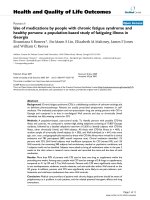Biophysiological signal analysis through electromyography in people with tremor
Bạn đang xem bản rút gọn của tài liệu. Xem và tải ngay bản đầy đủ của tài liệu tại đây (419.2 KB, 9 trang )
International Journal of Mechanical Engineering and Technology (IJMET)
Volume 10, Issue 12, December 2019, pp. 294-302, Article ID: IJMET_10_12_032
Available online at />ISSN Print: 0976-6340 and ISSN Online: 0976-6359
© IAEME Publication
BIOPHYSIOLOGICAL SIGNAL ANALYSIS
THROUGH ELECTROMYOGRAPHY IN
PEOPLE WITH TREMOR
Angie J Valencia C
Faculty of Engineering
Militar Nueva Granada University, Bogotá D.C., Colombia
Mauricio Mauledoux
Faculty of Engineering
Militar Nueva Granada University, Bogotá D.C., Colombia
Edilberto Mejia-Ruda
Faculty of Engineering
Militar Nueva Granada University, Bogotá D.C., Colombia
Ruben D. Hernández
Faculty of Engineering
Militar Nueva Granada University, Bogotá D.C., Colombia
Óscar F. Avilés
Faculty of Engineering
Militar Nueva Granada University, Bogotá D.C., Colombia
ABSTRACT
Tremor is defined by a series of muscular contractions that produce agitated
movements in different parts of the body, most often affecting the hands, followed by
the arms, head, vocal cords, torso and legs. This can be constant or intermittent,
sporadic, or as a result of another usually neurological disorder. The frequency of the
tremor, that is, the "speed" of the shock may decrease as the person ages, while the
intensity of the tremor increases. Strong emotions, stress, fever, physical exhaustion or
low blood sugar can trigger the tremor or increase its intensity [1]. With the above,
the main causes for which muscle disorders are considered as a case study are
exposed, for the development of research that leads to obtaining solutions that
improve the quality of life of people who suffer from them. For this, the acquisition of
electromyography signals acquired through a MYO is performed in patients who
emulate tremor.
Keywords: Quality of Life, Neurodegenerative Diseases, Medium Square Error,
Effort, MYO, Oscillating Movements, Tremor
/>
294
Biophysiological Signal Analysis Through Electromyography in People with Tremor
Cite this Article: Angie J Valencia C, Mauricio Mauledoux, Edilberto Mejia-Ruda,
Ruben D. Hernández, Óscar F. Avilés, Biophysiological Signal Analysis Through
Electromyography in People with Tremor. International Journal of Mechanical
Engineering and Technology 10(12), 2019, pp. 294-302.
/>
1. INTRODUCTION
The first investigations on the suppression of tremor by means of biomechanical mechanisms
resulted in devices that were mostly non-ambulatory and that depended on the damping
forces. [2. 3]. Then, auxiliary (outpatient) devices were presented that involve the joints of the
upper limbs, the wrist and the elbow, with suppression technologies that ranged from passive
damping to active damping, using actuators such as electric motors, among others [4, 5, 6, 7].
Likewise, functional electrical stimulation and soft actuators, based on conductive
polymers and piezoelectric fiber compounds, have been suggested as an alternative to rigid
systems [8, 9, 10, 11, 12]. The recognized limitation for electrical stimulation works include
redundancy and coupling of the muscles involved in joint activations, while the limitation in
terms of hardware by surface electrodes consists of access to specific muscles and fatigue
muscular.
For the proper management of the techniques that must be implemented in the
development of devices that contribute to the rehabilitation of patients with pathological
tremor, the tremor and voluntary components of a registered signal must be distinguished in
the first instance, either for diagnosis or treatment. In-line decomposition of the signal, in
particular, poses a greater challenge than an offline calculation, which has employed
strategies ranging from linear filtering to stochastic estimators. In [13] an optimal digital filter
was designed offline through follow-up tasks. In [7] they used a second order low pass filter
applied to an electromyography tremor signal to be transmitted to a neural network, intended
to control an elbow device. In [14] they used a high-pass filter to separate the tremor
component before passing it to a repetitive control loop using a functional electrical
stimulation system. Another recent work used a tremor estimator in the form of a high-pass
filter, which resulted in a significant phase change, which was corrected before being applied
to the suppressor actuator [15].
It is not uncommon to evaluate the methods of tremor suppression by performing
simulations, either numerically or experimentally and obtaining access (with the consent of an
ethical committee) to patients once the simulations have given optimal results [11, 15, 16, 17,
18, 19, 20, 21]. These can promote optimization and debugging of the suppression system and
therefore improve performance. In addition, patient recordings can be used to simulate the
tremor profile by helping to narrow the gap between simulations and tests with subjects.
As for the control strategies that have been contemplated for the management of
biomechanical mechanisms for rehabilitation, those that work on the impedance are taken into
account, which attempt to modify the man-machine frequency response so that a greater
impedance is present in the tremor frequencies [4, 22, 23]. The disadvantage of this control
lies in the sensitivity to inaccuracies in the parameters of the human-machine model or
changes thereof over time.
Other techniques to suppress tremor are based on inertial sensors, by means of the
detection of interaction forces between the user and the suppression system as a feedback
measure. In [24], they guide a tremor suppression device to follow the voluntary movement of
a user who has tremor. The device suppresses the tremor by resisting the respective
movement, while simultaneously moving along with the voluntary movement. In addition, an
orthosis system was developed to validate the tremor suppression approach directed at the
/>
295
Angie J Valencia C, Mauricio Mauledoux, Edilberto Mejia-Ruda, Ruben D. Hernández, Óscar F. Avilés
human elbow, consisting of a suppression motor, gears, sensors that include a force transducer
and an encoder, next to the upper arms and of the forearm.
In [25], a neuro prosthesis was implemented that regulated the level of muscle cocontraction by injecting current through transcutaneous neuro-stimulation. The co-contraction
was adapted to the instantaneous tremor parameters that were estimated from the raw
recordings of a pair of solid-state gyros with an adaptive algorithm designed on purpose. In
the end, the results presented demonstrate that the neuro prosthesis provides a systematic
attenuation of the two main types of tremor, regardless of their severity.
The present work is structured as follows: Section 1, where the procedure for the
acquisition of electromyographic signals is shown. In section 2, the processing of the acquired
signals is performed. Finally, in section 3 conclude on the procedures performed.
2. ACQUISITION OF ELECTROMIOGRAPHIC SIGNS
2.1. System Calibration
For the acquisition of electromyography data in the upper limb of patients with tremor, the
MYO is used as a transducer device. From there it starts with calibration steps to configure
the orientation of the device, from movements such as forearm flexion (a), an extension
movement (b), lateral forearm rotation (c), average forearm rotation (d) , supination
movement (e) and pronation movement (f), as seen in Figure 1, where the direction of the red
vector indicates the position of the hand and the cylinder emulates the behavior of the
forearm.
(a)
(b)
(c)
(d)
(e)
(f)
Figure 1. Calibration Movements.
2.2. Acquisition of Data in People with and without Tremor
After performing the calibration of the system, we proceed with the acquisition of
biophysiological signals of people with and without tremor from the execution of daily tasks
such as drinking a drink. For this, similar test conditions are stipulated in the test subjects
such as a constant vessel weight and a defined trajectory. From there, figures 2 and 3 are
obtained for a speed behavior on the X axis, figures 4 and 5 for the Y axis, and figures 6 and 7
for the Z axis.
/>
296
Biophysiological Signal Analysis Through Electromyography in People with Tremor
Sick
Time
Figure 2. Speed person with tremor X axis
Healthy
Time
Figure 3. Speed person without tremor X axis
Sick
Time
Figure 4. Speed person with tremor Y axis
Healthy
Time
Figure 5. Speed person without tremor Y axis
/>
297
Angie J Valencia C, Mauricio Mauledoux, Edilberto Mejia-Ruda, Ruben D. Hernández, Óscar F. Avilés
Sick
Time
Figure 6. Speed person with tremor Z axis
Healthy
Time
Figure 7. Speed person without tremor Z axis
The acceleration behaviors of the three quadrants are then obtained as shown in Figure 8 through 13.
Sick
Time
Figure 8. Acceleration person with tremor X axis
Healthy
Time
Figure 9. Acceleration person without tremor X axis
/>
298
Biophysiological Signal Analysis Through Electromyography in People with Tremor
Sick
Time
Figure 10. Acceleration person with tremor Y axis
Healthy
Time
Figure 11. Acceleration person without tremor Y axis
Sick
Time
Figure 12. Acceleration person with tremor Z axis
Healthy
Time
Figure 13. Acceleration person without tremor Z axis
/>
299
Angie J Valencia C, Mauricio Mauledoux, Edilberto Mejia-Ruda, Ruben D. Hernández, Óscar F. Avilés
3. RESULTS AND DISCUSSION
To finally determine the variability in the data of a person with and without tremor taking into
account the values of mean, variance and standard deviation, grouped in table 1.
Table 1: Variability calculation
Parameter
Sick X Speed
Healthy X Speed
Sick Y Speed
Healthy Y Speed
Sick Z Speed
Healthy Z Speed
Sick X acceleration
Healthy X acceleration
Sick Y acceleration
Healthy Y acceleration
Sick Z acceleration
Healthy Z acceleration
Average
-2.6027
2.0111
10.4901
-3.9418
-6.0371
-14.7240
-0.0664
0.0373
-0.1472
0.9013
0.9117
0.2428
Variance Standard Deviation
179.3621
13.3926
141.9056
11.9124
276.2873
16.6219
13.7175
3.7037
51.8823
7.2029
635.9661
25.2184
0.0101
0.1006
0.0192
0.1387
0.0040
0.0633
0.0022
0.0474
0.0019
0.0431
0.0014
0.0375
Then it is done in the calculation of the average normalized quadratic error, in order to
estimate when the movement has to be corrected in a person with a tremor with respect to one
who does not have it. This error is stipulated in table 2.
Table 2: Error Analysis
Parameter
Speed X Sick vs Healthy
Speed Y Sick vs Healthy
Speed ZSick vs Healthy
Acceleration X Sick vs Healthy
Acceleration Y Sick vs Healthy
Acceleration Z Sick vs Healthy
Standard Normalized Quadratic Error
-88.7124
-13.3943
8.9985
-9.6012
-8.3381
2.0385
4. CONCLUSIONS
With respect to the data obtained, it can be observed that in the X and Y quadrants a person
without tremor has freedom of movement and with it more speed in its execution. While there
is greater variability in movement in the Z axis as seen in Table 2, there are higher speeds in
this axis when it comes to a person with involuntary behavior in their upper extremities.
As for the behavior in acceleration, it can be concluded that in the X and Y quadrants,
since there is greater speed in a person without tremor with respect to the one who does not
have it, there is directly proportionally greater acceleration. And finally, on the Z axis, since
there are no oscillations in a healthy person, there is less acceleration compared to that with
involuntary behaviors.
ACKNOWLEDGEMENT
The research for paper was supported by Military Nueva Granada University by research
project ING 2658.
/>
300
Biophysiological Signal Analysis Through Electromyography in People with Tremor
REFERENCES
[1]
Elble, Rodger, and Günther Deuschl (2011). "Milestones in tremor research." Movement
Disorders 26(6), 1096-1105.
[2]
Hendriks, J., Rosen, M., Berube, N., & Aisen, M. (1991, June). A second-generation
joystick for people disabled by tremor. In Proceedings of the 14th annual RESNA
conference (pp. 21-26). RESNA
[3]
Aisen, M. L., Arnold, A., Baiges, I., Maxwell, S., & Rosen, M. (1993). The effect of
mechanical damping loads on disabling action tremor. Neurology, 43(7), 1346-1346.
[4]
Rocon, E., Belda-Lois, J. M., Ruiz, A. F., Manto, M., Moreno, J. C., & Pons, J. L. (2007).
Design and validation of a rehabilitation robotic exoskeleton for tremor assessment and
suppression. IEEE Transactions on Neural Systems and Rehabilitation Engineering, 15(3),
367-378.
[5]
Kotovsky, J., & Rosen, M. J. (1998). A wearable tremor-suppression orthosis. Journal of
rehabilitation research and development, 35(4), 373.
[6]
Loureiro, R. C., Belda-Lois, J. M., Lima, E. R., Pons, J. L., Sanchez-Lacuesta, J. J., &
Harwin, W. S. (2005, June). Upper limb tremor suppression in ADL via an orthosis
incorporating a controllable double viscous beam actuator. In Rehabilitation Robotics,
2005. ICORR 2005. 9th International Conference on (pp. 119-122). IEEE.
[7]
Ando, T., Watanabe, M., Nishimoto, K., Matsumoto, Y., Seki, M., & Fujie, M. G. (2012).
Myoelectric-controlled exoskeletal elbow robot to suppress essential tremor: extraction of
elbow flexion movement using STFTs and TDNN. Journal of Robotics and Mechatronics,
24(1), 141-149.
[8]
Manto, Mario, Mike Topping, Mathijs Soede, Javier Sanchez-Lacuesta, William Harwin,
Jose Pons, John Williams, Steen Skaarup, and Lawrence Normie (2003). "Dynamically
responsive intervention for tremor suppression." IEEE engineering in medicine and
biology magazine 22 (3),120-132
[9]
Swallow, L., & Siores, E. (2009). Tremor suppression using smart textile fibre systems.
Journal of Fiber Bioengineering and Informatics, 1(4), 261-266.
[10]
Maneski, L. P., Jorgovanović, N., Ilić, V., Došen, S., Keller, T., Popović, M. B., &
Popović, D. B. (2011). Electrical stimulation for the suppression of pathological tremor.
Medical & biological engineering & computing, 49(10), 1187.
[11]
Zhang, D., Poignet, P., Widjaja, F., & Ang, W. T. (2011). Neural oscillator based control
for pathological tremor suppression via functional electrical stimulation. Control
Engineering Practice, 19(1), 74-88.
[12]
Dideriksen, J. L., Muceli, S., Dosen, S., & Farina, D. (2014). Physiological Recruitment of
Large Populations of Motor Units Using Electrical Stimulation of Afferent Pathways. In
Replace, Repair, Restore, Relieve–Bridging Clinical and Engineering Solutions in
Neurorehabilitation (pp. 351-359). Springer, Cham.
[13]
Gonzalez, J. G., Heredia, E. A., Rahman, T., Barner, K. E., & Arce, G. R. (2000). Optimal
digital filtering for tremor suppression. IEEE Transactions on Biomedical Engineering,
47(5), 664-673.
[14]
Verstappen, R. J., Freeman, C. T., Rogers, E., Sampson, T., & Burridge, J. H. (2012,
October). Robust higher order repetitive control applied to human tremor suppression. In
Intelligent Control (ISIC), 2012 IEEE International Symposium on (pp. 1214-1219).
IEEE.
/>
301
Angie J Valencia C, Mauricio Mauledoux, Edilberto Mejia-Ruda, Ruben D. Hernández, Óscar F. Avilés
[15]
Taheri, B., Case, D., & Richer, E. (2014). Robust controller for tremor suppression at
musculoskeletal level in human wrist. IEEE Transactions on neural systems and
rehabilitation engineering, 22(2), 379-388.
[16]
Veluvolu, K. C., Latt, W. T., & Ang, W. T. (2010). Double adaptive bandlimited multiple
Fourier linear combiner for real-time estimation/filtering of physiological tremor.
Biomedical Signal Processing and Control, 5(1), 37-44.
[17]
Wang, S., Gao, Y., Zhao, J., & Cai, H. (2014). Adaptive sliding bandlimited multiple
fourier linear combiner for estimation of pathological tremor. Biomedical Signal
Processing and Control, 10, 260-274.
[18]
Popović, L. Z., Šekara, T. B., & Popović, M. B. (2010). Adaptive band-pass filter (ABPF)
for tremor extraction from inertial sensor data. Computer methods and programs in
biomedicine, 99(3), 298-305.
[19]
Hashemi, S. M., Golnaraghi, M. F., & Patla, A. E. (2004). Tuned vibration absorber for
suppression of rest tremor in Parkinson's disease. Medical and Biological Engineering and
Computing, 42(1), 61-70.
[20]
Taheri, B., Case, D., & Richer, E. (2012, October). Design and development of a human
arm joint simulator for evaluation of active assistive devices control algorithms. In ASME
2012 5th Annual Dynamic Systems and Control Conference joint with the JSME 2012
11th Motion and Vibration Conference (pp. 707-714). American Society of Mechanical
Engineers.
[21]
Taheri, B., Case, D., & Richer, E. (2015). Adaptive suppression of severe pathological
tremor by torque estimation method. IEEE/ASME Transactions on Mechatronics, 20(2),
717-727.
[22]
Taheri, B., Case, D., & Richer, E. (2011, January). Active tremor estimation and
suppression in human elbow joint. In ASME Conference Proceedings (Vol. 54761, No.
2011, pp. 115-120).
[23]
Pledgie, S., Barner, K. E., Agrawal, S. K., & Rahman, T. (2000). Tremor suppression
through impedance control. IEEE Transactions on rehabilitation engineering, 8(1), 53-59.
[24]
Herrnstadt, G., & Menon, C. (2016). Voluntary-driven elbow orthosis with speedcontrolled tremor suppression. Frontiers in bioengineering and biotechnology, 4.
[25]
Gallego, J. Á., Rocon, E., Belda-Lois, J. M., & Pons, J. L. (2013). A neuroprosthesis for
tremor management through the control of muscle co-contraction. Journal of
neuroengineering and rehabilitation, 10(1), 36.
/>
302









